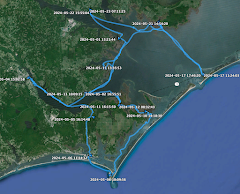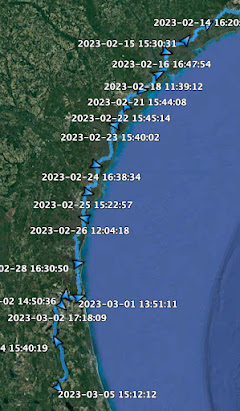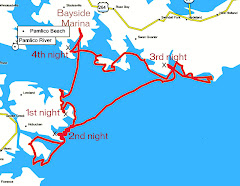
I drilled out all the screw holes on the main mast today with a 1/4 inch drill bit. Then cut 1/4 inch mahogany dowell into inch long pieces, dipped them into thickened epoxy and, with a rubber mallet, tapped them into the holes in the mast. Eighteen holes in all, six I think for the screws for the track that the goose neck rested on, the others for existing screw holes for eye straps, etc. for the halyards, lazy jacks and pennant. It was a nice warm day, the epoxy cooked off quickly. Tomorrow I'll cut off the excess pieces of wood, sand smooth and - if the weather is as nice as today - coat the entire mast with clear epoxy. When I re-install the hardware I'll be putting the screws into fresh hardwood
It was an enjoyable afternoon. If I get the epoxy work done this weekend I'll try and start on the varnish next weekend.
I've been thinking more about digital waterproof cameras. I been getting some input from friends. There are a handful of good, reasonably priced cameras out there. My analysis started with a NY Times review of adventure cameras. The review is over a year old, so some of the information is out of date. The reviewer rated, at the time, the Canon Powershot D10 as the best camera. The Pentax Optio W60 came in third. The W60 is, I think, two generations out of date. There was a W80 and now a W90 (which includes a major redesign). I'm pretty sure the Pentax Optio W90 will fit both my needs and pocketbook. But I will continue researching.
 One of the things I looked at when analyzing the cameras were the customer ratings. Just about all the cameras had their ratings lowered by customers that gave them one star out of five generally because they leaked while skin diving down at depths of 20 or 30 feet for extended periods of time - i.e. a half hour or so. In my opinion these cameras, while called waterproof, can't be expected to remain waterproof that deep for that long.
One of the things I looked at when analyzing the cameras were the customer ratings. Just about all the cameras had their ratings lowered by customers that gave them one star out of five generally because they leaked while skin diving down at depths of 20 or 30 feet for extended periods of time - i.e. a half hour or so. In my opinion these cameras, while called waterproof, can't be expected to remain waterproof that deep for that long.
 One of the things I looked at when analyzing the cameras were the customer ratings. Just about all the cameras had their ratings lowered by customers that gave them one star out of five generally because they leaked while skin diving down at depths of 20 or 30 feet for extended periods of time - i.e. a half hour or so. In my opinion these cameras, while called waterproof, can't be expected to remain waterproof that deep for that long.
One of the things I looked at when analyzing the cameras were the customer ratings. Just about all the cameras had their ratings lowered by customers that gave them one star out of five generally because they leaked while skin diving down at depths of 20 or 30 feet for extended periods of time - i.e. a half hour or so. In my opinion these cameras, while called waterproof, can't be expected to remain waterproof that deep for that long. I grew up in Southern California, diving and taking photographs in the kelp beds along the coast and in the channel islands. The camera housings we used at the time cost $700 to $1000, were made of cast aluminum and were sealed with O-rings that were easily accessible for routine maintenance. The point and shoot "waterproof" adventure cameras above are not designed at all like the marine housings we used. About the only maintenance you can give them is a good rinsing in fresh water. O-rings? I bet you couldn't find one on these cameras if you tried.
I consider these cameras to be "water resistant" and expect them to withstand a good soaking from a storm or a batch of salt spray coming over the side. I would not ask for anything more than that. In the photograph Bruce shot of me below on Wysocking Bay you can see me holding my "waterproof" camera well above the water. That's the way I think these cameras are best treated. Take them 20 feet under the surface? Take your chances.


Speaking of sailing and cameras, check out this video by our friend Kevin of Slip Jig fame. Pretty cool stuff Kevin.
steve











































5 comments:
Steve, I think you're right about the Pentax W90. That's the conclusion I came to as well, after thorough research. I ended up going with a Canon S95 though (see Ken Rockwell's rave about the S90), because I'm not sailing anymore, and what waterproofness I need I can get with a ziplock baggie. I opted for "greatness" over waterproofness. Mind you, if you have the bucks, you can get a "waterproof" housing for the S95. It makes it a bulkier item, but it looks like it might have an o-ring or two! :-)
-Eric
- - - - -
http://www.kenrockwell.com/canon/s90.htm
http://www.adorama.com/ICAWPDC38.html
Steve, I had a Pentax Optio W60. It lasted about 4 sessions of in-water use. I never took it more than 3 feet below the surface. I really was disappointed. I have a Canon S90 and think it is a terrific camera. Depending on how much the housing costs for it, that would be something I would consider. The S95 fixes a couple of handling issues ...Ken Rockwell does a great review...but shares the same low-noise sensor and fast lens.
Really enjoy reading your blog!
Murray
Thanks for the info Eric and Murray. While putting a camera in a housing is great for underwater use, it doesn't work so well out of water. The clear housings can turn into little greenhouses and heat can build up inside of the housing. The one housing I did look at came with a warning for heat build up, it said the camera battery could explode.
My optio w20 was underwater really just once in four or five years of use and that was just briefly. The rest of the time it was exposed to just the usual splash, spray and rain of a typical sailing trip.
Everything is a trade off, I'll just have to figure out what works best on a small boat.
Steve
Hi Steve,
I wear my Optio W30 in a case on my hip (even while swimming) and I never think twice about submerging it. There actually are o-rings sealing the two access doors. My rule of thumb has been if I can still breathe, the camera's not too deep.
So far the camera has worked fine for about three years.
Thanks Ken.
steve
Post a Comment